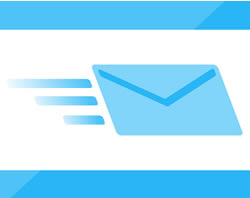Kyra Sutton* says it’s essential to know when email is an appropriate way to communicate with someone at work — and when it isn’t.

Image: 200 Degrees
Dear Favourite Person [insert evil grin]:
If you send me one more email about ____ (really anything!), I am certain what remains of our fragile working partnership will no longer be possible to maintain.
We’ve exchanged no fewer than 10 emails about the same topic, and I have attempted to respond to all of your inquiries.
You’ve asked a number of questions that are all related to conversations we’ve had in the not-so-distant past.
Moreover, we had a kickoff call during which many of the questions you asked over email were addressed.
I suppose we’re at a point where one must consider: Is it me or is it you?
I am inclined to believe it is you.
I would like to save you the trouble of sending your 11th email.
I’ve set up a special rule for your emails.
Specifically, any email with your name as the sender goes directly to my trash folder.
While this is not a practice I would generally support, it’s obvious your goal is to make my day difficult and unproductive.
Signed,
I Am Over It!
Ready to hit send?
Perhaps even to tailor this email to your own circumstances?
I understand!
In fact, not too long ago I wanted to send a replica of this email to a colleague who was unreasonable in his demands and perpetually bothersome.
However, what happens if you send this email (or something similar)?
It explodes.
Consequences are likely to follow, and the ramifications will be significant.
Why?
Because everything you do at work is a reflection of your personal brand and reputation.
And while the temporary high of telling off a co-worker, who is undoubtedly a jerk, is tempting, it is not worth risking your reputation.
Based on my experience, here are 10 workplace examples of when email is the best communication medium.
- You can resolve a problem.
If you are faced with a problem that can be solved with an email, you have hit the jackpot.
If people reach out to you for help, it’s because they trust you will be able to give it.
If you can offer an answer, not waste anyone’s time and take something off someone’s to-do list, you are doing well!
- You have a question.
Suppose you have a question and you are pretty sure you know the answer, but you need confirmation.
Email is your friend.
- You need to communicate a new initiative.
Suppose you have been working on a project and the solution you helped create needs to be communicated with stakeholders.
Email is your friend.
In fact, you should send out an initial email to your stakeholders and follow up with a call to address any questions they may have.
- You need to remind the group of something.
Email is great when you need to send out reminders to your stakeholders — for example, to ensure they complete any outstanding tasks.
- You need to clarify a meeting’s purpose.
Another way of using email is to tell a group of stakeholders what will be accomplished in an upcoming meeting.
- You need to find or disseminate resources.
Email can be helpful when you want to locate resources.
If the resource is a person, you could ask “Does someone on the team have advanced programming experience?”
You can also use email to share resources, such as data.
- You need to build a relationship.
I fully believe in the power of building relationships, but they take time to develop.
You can move things forward by sending an email.
Personalise it by stating something you have in common with the individual.
- You want to keep in touch.
Outside of work, there are several types of people with whom you should maintain contact.
Examples include former professors, mentors and individuals you meet at conferences.
If the person is not your friend in the traditional sense of the word, don’t text them.
Instead, send an email and keep them abreast of progress you are making in your career.
- You want to update the team on a project.
If you have a project update that requires no additional decision-making or discussion among your stakeholders and you want to communicate the progress you’ve made, send an email.
- You want to share positive feedback.
While development feedback such as “it could have been better if” should be shared in person, use email to share a positive experience.
In fact, when you share positive experiences, email the individual and copy his or her manager on the message.
Be sure to include how the person helped you and what you were able to accomplish with his or her assistance.
There is a time and place for email.
Just make sure to use it responsibly at work.
* Kyra Sutton is a faculty member at Rutgers University’s School of Management & Labour Relations.
This article first appeared at www.shrm.org.











